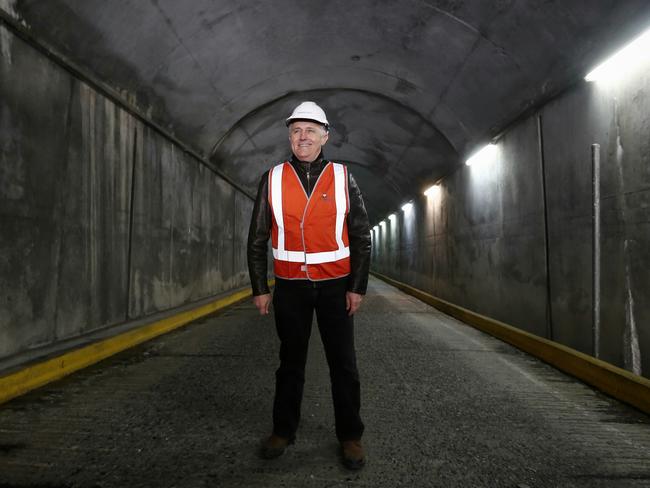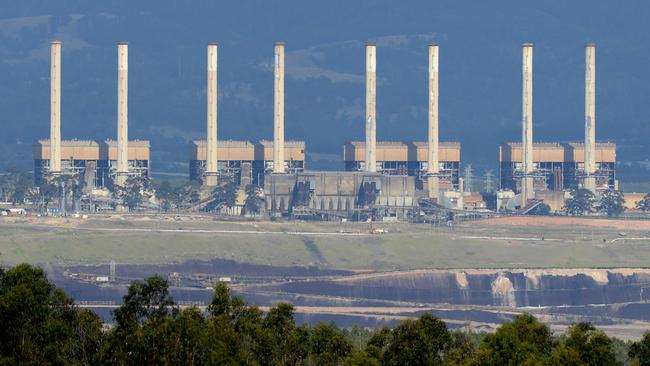Are you willing to pay $4 billion to support ‘clean’ coal-fired power plants?
POWER prices have been going up and blackouts have been increasing. Now some are pushing for a very expensive solution.
EVERYONE seems to have different opinions about the best way to keep Australia’s lights on and now some government politicians are pushing for one controversial solution.
Overnight it emerged that a group of more than 20 government MPs dubbed the “Monash Forum”, have apparently formed an alliance against Malcolm Turnbull over his energy policy.
They’re keen to lobby for the construction of “clean” coal-fired power stations and it’s no surprise the forum counts among its members former prime minister Tony Abbott, former ministers Kevin Andrews and Eric Abetz as well as Nationals MPs George Christensen and Barnaby Joyce.
This pro-coal group says it’s worried about the high cost of electricity and wants new coal-fired powered stations to be supported as part of Mr Turnbull’s National Energy Guarantee. So does it have a point?
HOW MUCH WILL IT COST?
The Minerals Council has suggested “clean coal” power plants like a 1000 megawatt HELE (high-efficiency, low-emissions) or ultrasupercritical coal-fired power station could be built for as little as $2.2 billion.
However, others have disputed this figure, saying it does not include project development, finance and legal fees and interest costs during construction.
As Ben Potter wrote in the Australian Financial Review, “Australia is famous for delay and ‘lawfare’, so this is a big exclusion”.
He believes the cost would be more likely to mimic expenses in the United States, where the country’s only HELE plant took six years to build and cost $US1.8 billion ($AU2.3 billion) for 60 MW a decade ago, due to civil cases and regulation. This would bring the figure closer to $US3 billion ($AU3.9 billion) for a 1000 MW plant.
In comparison, Malcolm Turnbull has suggested an extension to the Snowy Hydro scheme which is estimated to cost up to $AU4.5 billion for up to 2000 MW of power. It will be fully operational after eight years.

CAN WE GET ENOUGH POWER FROM RENEWABLES?
One of the biggest arguments against relying on renewables like solar and wind are fears around what happens when the sun isn’t shining and the wind isn’t blowing.
Even beyond generating enough electricity for households (we’ve all seen the problems in South Australia) experts have said it’s not possible at the moment for renewables to be used for industrial processes, like producing steel and making cement, where it’s essential to have large amounts of reliable power around-the-clock.
“Therefore, coal and CCS (carbon capture and storage) will likely need to be used,” an IEA analyst told news.com.au last year.
But Tony Wood, energy program director of the Grattan Institute, disagreed and said he believed it was “absolutely possible” to deliver enough power for these processes.
He said the main obstacle was finding a way to store large amounts of electricity for when it was needed but this may be possible through pumped hydro and the use of batteries.
“The question is how quickly do we scale up, and how much does it cost?” Mr Wood said.
Such a large-scale project has not yet been done and he said it was important to understand the costs through things like feasibility studies.
SO IS BUILDING CLEAN COAL POWER PLANT A BAD IDEA?
Mr Wood said if building a clean coal-fired power plant was a commercially viable thing to do, private companies would be doing it today.
But to be fair, one thing that has made this difficult is the lack of agreement about environmental policy in Australia.
Liberal backbencher Craig Kelly, a member of the Monash Forum, was right when he told ABC this morning: “The problem that you have, is to build a coal-fired power station requires an investment of 30 to 40 years, and because of the potential of technological change and also because of the sovereign risk of changes in government over that period, which may change the rules over 30 to 40 years, it becomes difficult for the private sector to invest in that.”
Essentially businesses don’t want to invest in these power plants because they don’t know whether governments will change their minds about emissions targets and how they will be achieved.
A new power plant could take more than five years to build and emissions targets are likely to become more strict, meaning its operational life could be shortened to 10-20 years. In the past power plants had a lifespan of about 50 years.
Mr Kelly’s solution to this is for the government to take on this risk, which means taxpayers will be footing the bill if it loses money.
But Mr Wood said Australia had made the decision 20 years ago that the best way of securing affordable electricity was to take advantage of the commercial market.
“If we return to a nationalised market — a government-owned system — I feel we would hesitate very strongly before doing that, and I would be surprised if a Liberal National coalition government would go down that path,” he said.
While some have pointed out that other countries are building new power plants, Mr Wood said the situation in Australia was different.
“Other countries still need an enormous amount of new power but Australia doesn’t, our demand is actually falling so our needs are different to where these power plants are being built,” he said.
He said the real question was: why should we build a coal-fired power plant?’
“Unless it was highly subsidised, it probably wouldn’t bring the price of electricity down,” Mr Wood said.
RELATED: Real reasons why our power prices are going up

Instead he said a clear policy, such as the Turnbull Government’s National Energy Guarantee, which tried to integrate energy and climate policy, would provide the right signal to investors.
“If we’ve got the right policy settings in place, we will get the investment we need,” he said.
The answer may even be to extend the life of existing power plants rather than build new ones.
“Sometimes the best resources are the ones we’ve already got,” he said.
When asked if there was a strong argument for the government to build a new power plant he said: “Quite simply, no.”
Mr Wood said people had two main concerns, one was high prices and the other was reliability.
“There are both absolutely valid concerns but you’ve got to make sure once you’ve identified the problem, that you put forward the best solution and it’s not obvious to me that the best solution is building a new coal-fired power plant.”
Some may look at the technology and decide there is a business case for it, even in a world that increasingly values low emissions, and they should be supported, he said, but “I wouldn’t put my money into it”.
However, he added: “It shouldn’t be up to me and it shouldn’t be up to the government to chose the technology”.
CAN WE STILL MEET OUR EMISSIONS TARGETS?
Mr Wood said Australia could met its emissions targets “up to a point” by building HELE or supercritical power plants.
These new plants produce about 0.8 or 0.9 tonnes of carbon dioxide for each megawatt hour of electricity produced. This is much lower than the now-closed Hazelwood power plant in Victoria, which was the highest polluting station in Australia — that produced about 1.5 tonnes. On average coal-fired power plants produce less than 1 tonne of carbon dioxide and gas produces about 0.4 tonnes.
“If we replace old power plants with new ones, our emissions would come down,” Mr Wood said. “The challenge is to keep them coming down.”
While combining new clean coal and renewables could reduce emissions for a while, targets would almost certainly become more stringent over time, and this is when it would become harder.



